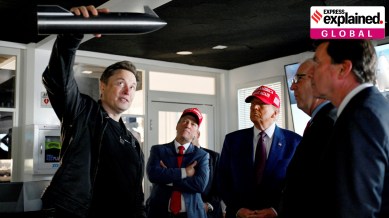How Trump-Musk break-up can severely affect NASA and its future space missions
Musk’s threat to decommission the Dragon spacecraft revealed the vulnerability of NASA which is now dependent on private companies for many critical systems in the space programme

Musk and Trump are engaged in a bitter war of words on social media, triggered by Musk’s strong criticism of a Congressional tax Bill that he claims will result in a massive increase in the national debt. Trump has hit back saying Musk was concerned about the bill’s provisions relating to tax credits on electric vehicles (EVs), which could adversely affect Tesla, the EV company of Musk.
Trump went on to say that the easiest way to save government money — “billions and billions of dollars” — was to terminate government contracts and subsidies for Musk’s companies. Musk retorted that in the light of the President’s statement, SpaceX would begin decommissioning of its Dragon spacecraft “immediately”. He relented a few hours later, saying the decommissioning won’t happen.
NASA’s reliance on SpaceX
The Crew Dragon spacecraft of SpaceX is currently the only reliable vehicle that NASA has to transport astronauts to and from the ISS, a permanent laboratory in space, about 400 km from Earth, that is manned throughout the year. The ISS is used mainly by astronauts from the US and Russia, but occasionally those from other countries also make short visits, just like Shukla’s crew would be doing next week.
The astronauts on ISS are typically changed twice a year. In addition, three to four cargo missions are also sent to the ISS every year. Russian astronauts typically travel in the Soyuz spacecraft built by the Russian agency Roscosmos.
But NASA has discontinued its space shuttle programme, which included vehicles such as Atlantis, Discovery or Endeavour, primarily on cost considerations. The last NASA space shuttle mission was flown in Atlantis in 2011. These space shuttles used to be launched by NASA’s own rockets. The discontinuation of the space shuttle programme stopped the production of these rockets as well.
Between 2011 and 2020, NASA used the Russian transport, Soyuz, for travel to the ISS. After that, it has been hiring SpaceX’s Dragon spacecraft, which launches exclusively on the Falcon 9 rocket, also of SpaceX.
NASA has also contracted other companies, notably Boeing, to transport astronauts and cargo to the ISS. Boeing’s Starliner has carried out a few cargo sorties but its first crewed mission, carrying Sunita Williams and Butch Wilmore, last year was a troubled one. The Starliner, which uses Boeing’s Atlas rockets to launch, managed to drop the astronauts at the ISS, but was rendered risky for a return journey due to a technical glitch. The two astronauts were stranded at the ISS for nine months before a SpaceX mission brought them back in February this year.
The ISS missions are only one part of NASA’s increasing reliance on SpaceX. Musk’s company, which started in 2006 and has grown to become the largest private space corporation, is heavily involved with the Artemis programme as well, the ambitious NASA plan to get humans back to the Moon, this time for extended periods of time. The crewed missions under the Artemis programme are expected to use the Starship spacecraft of SpaceX. The first of the crewed missions is scheduled for 2027.
Extra-planetary exploration missions, like those to Saturn, are also being done in collaboration with SpaceX. In many segments, SpaceX has developed superior technologies that have increased NASA’s dependence on it.
SpaceX has also created a constellation of satellites to provide Internet services around the world. NASA is not linked to this network, but some other US government agencies are, creating dependencies elsewhere too. A Reuters report said SpaceX had about $22 billion worth of government contracts, across different agencies. The contract to transport astronauts to the ISS on the Dragon spacecraft was alone worth about $5 billion, it said.
Feud not over